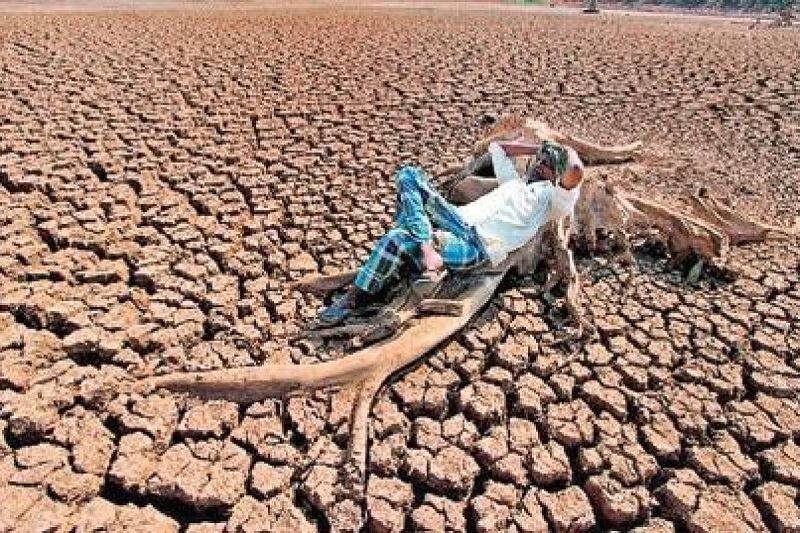
New Delhi- Rising global temperatures may lead to more frequent and longer-lasting droughts in India, while posing significant risks to people and ecosystems around the world, according to a study.
Researchers from the University of East Anglia (UEA) in the UK found that even a modest temperature increase of 1.5 degrees Celsius will spell serious consequences in India, China, Ethiopia, Ghana, Brazil and Egypt.
The study, published recently in the journal Climatic Change, quantified the projected impacts of alternative levels of global warming upon the probability and length of severe drought in the six countries.
“Current pledges for climate change mitigation, which are projected to still result in global warming levels of 3 degrees Celsius or more, would impact all the countries in this study,” said Jeff Price, Associate Professor of Biodiversity and Climate Change at UEA,.
“For example, with 3 degrees Celsius warming, more than 50 per cent of the agricultural area in each country is projected to be exposed to severe droughts lasting longer than one year in a 30-year period,” Price said in a statement.
Using standard population projections, the researchers estimated that 80 per cent to 100 per cent of the population in Brazil, China, Egypt, Ethiopia and Ghana, are projected to be exposed to a severe drought lasting one year or longer in a 30-year period.
For India, nearly 50 per cent of the population is projected to be exposed to a severe drought lasting one year or longer in a 30-year period, they said.
In contrast, the study found that meeting the long-term temperature goal of the Paris Agreement, that is limiting warming to 1.5 degrees Celsius above pre-industrial levels, is projected to greatly benefit all of the countries in this study.
Meeting the target will greatly reduce exposure to severe drought for large percentages of the population and in all major land cover classes, with Egypt potentially benefiting the most, the researchers said.
In the 1.5 degrees Celsius warming scenario, the drought probability is projected to triple in Brazil and China, nearly double in Ethiopia and Ghana, increase slightly in India, and substantially increase in Egypt, they said.
The study found that in a 2 degrees Celsius warming scenario, the probability of drought is projected to quadruple in Brazil and China, double in Ethiopia and Ghana, reach greater than 90 per cent probability in Egypt, and nearly double in India.
In a 3 degrees Celsius warming scenario, the probability of drought projected to be in Brazil and China is 30-40 per cent; 20-23 per cent in Ethiopia and Ghana; 14 per cent in India but nearly 100 per cent in Egypt, according to the researchers.
In a 4 degrees Celsius warming scenario, the probability of drought projected in Brazil and China is nearly 50 per cent; 27-30 per cent in Ethiopia and Ghana; nearly 20 per cent in India; and 100 per cent in Egypt, they said.
In most countries, the study found that the projected increase in drought probability increases approximately linearly with increasing temperature. The exception is Egypt, where even slight amounts of global warming potentially lead to large increases in drought probability, the researchers found.
“Not only does the area exposed to drought increase with global warming, but it also increases the length of the droughts,” said Professor Rachel Warren, who led the study.
“In Brazil, China, Ethiopia, and Ghana droughts of longer than two years are projected to occur even in a 1.5 degrees Celsius warming scenario,” Warren added.
The percentage of land projected to be exposed to a severe drought of longer than 12 months in a 30-year period is expected to increase rapidly by the 1.5 degrees Celsius warming scenario in Brazil, China and Egypt, and in areas of permanent snow and ice in India.
“India and China both have large areas currently under permanent’ ice and snow cover. However, in the 3 degrees Celsius warming scenario, 90 per cent of these areas are projected to face severe droughts lasting longer than a year in a 30-year period,” the authors of the study said.
“These areas form the headwaters of many major river systems, and thus the water supply for millions of people downstream. Increasing probability and duration of severe drought points to potential declines in water storage in the Chinese Himalayas in the form of snow and ice,” they added.
Follow this link to join our WhatsApp group: Join Now
Be Part of Quality Journalism |
Quality journalism takes a lot of time, money and hard work to produce and despite all the hardships we still do it. Our reporters and editors are working overtime in Kashmir and beyond to cover what you care about, break big stories, and expose injustices that can change lives. Today more people are reading Kashmir Observer than ever, but only a handful are paying while advertising revenues are falling fast. |
| ACT NOW |
| MONTHLY | Rs 100 | |
| YEARLY | Rs 1000 | |
| LIFETIME | Rs 10000 | |













